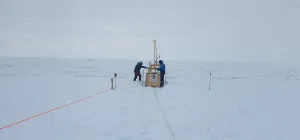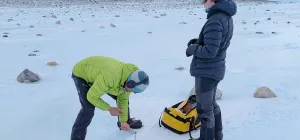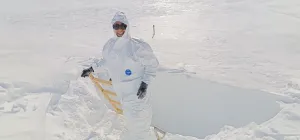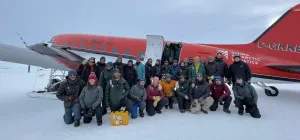The 2024-2025 BELgian Antarctic Research Expedition (BELARE) has officially begun with opening team hard at work!
The Princess Elisabeth Antarctica is opening for the 2024-2025 BELgian Antarctic Research Expedition (BELARE) and we look forward to another exciting season supporting scientific projects deep in the field.
The Princess Elisabeth Antarctica is opening for the 2024-2025 BELgian Antarctic Research Expedition (BELARE) and we look forward to another exciting season supporting scientific projects deep in the field.
The 2024–2025 austral summer research season is off to a strong start! The 14 lead members of the BELgian Antarctic Research Expedition (BELARE) team arrived at the Princess Elisabeth Antarctica - the world’s first and to date only zero-emission polar research station - from Cape Town, South Africa, to start the 2024-25 austral summer research season.
Soon after their arrival at the station last week, the BELARE team began clearing away snow around the station that had accumulated over the winter, switched the station’s energy production and management system from winter mode to summer mode, started melting snow for drinking water, and started up the station’s, new water treatment system.
After about a week of hard work getting the station up and running, the lead members of this year’s BELARE team have settled in and are already working hard on supporting this season’s scientific research projects.
Team members have been starting up, checking and reinstalling scientific equipment that collects data during the four months the station is occupied, including the CIMEL sunphotometer on the roof of the station, which measures direct sun and diffuse sky radiances from which aerosol depth, precipitable water vapour and albedo can be derived for the BIRA-CLIMB project.
Technicians and engineers have started preparing equipment and the living containers for scientists from the ULTMO and FROID projects, who will head deep into the field in the vicinity of Mount Belgica and south-west of the Sør Rondane Mountains respectively. These expeditions will spend several weeks in the field later this season. The FROID project will be focusing on finding the oldest ice while the ULTIMO team will be searching for meteorites and extra-terrestrial particles. The containers will give the scientists access to comfortable living quarters with a kitchen, showers, and modern communication links. Life in the field could be a lot worse!
At the same time, the team’s field guides are already mapping out routes for the scientists before they head into the field. A reconnaissance mission to find the safest path for scientists to take will be done before the scheduled arrival of scientists on November 28th.
Meanwhile, BELARE Expedition Leader Alain Hubert and mechanic Tim Grosrenaud headed to the coast to retrieve the last fuel drums that the cargo ship from last season had left at the coast in February. On the way, they stopped at Perseus Intercontinental Airfield to assess the condition of the runway. A lot of snow accumulated in the region over the winter, so a lot of work will need to be done to get the airfield ready for the arrival of the first cargo plane bringing the first teams of scientists, equipment and fresh supplies at the end of November. Today, a team of engineers and plumbers are heading to Perseus Airfield to start up the communication and heating system. Once this has been done, the team will get to work ploughing and grooming the runway so a cargo plane can land safely. It will be at least 10 days’ work to get everything ready for the arrival of the plane. It’s a considerable task!
As it’s still early in the season, temperatures outside can drop down to -20°C, with wind chill factor down to -32°C. So the team has to be careful when spending a long period of time outside. Next month, the average daily temperature outside will climb to a “balmy” -10°C and even -5°C.
As it’s springtime in Antarctica, snow petrels (Pagodroma nivea) are back making colonies on several nunataks around PEA including Utsteinen, where these seabirds have been coming for millennia to find a mate for life and a natural cavity under fallen rocks in which to lay their one egg for the season. Our resident biologist Henri Robert will be interested in tracking their progress in the coming weeks and months.
With several team members at Perseus, the station will be relatively quiet for the next two weeks. Of course, when the first scientists and additional IPF support staff arrive, the station will become a lot busier. In the meantime, we are all looking forward for the beginning of the field work. Stay tuned for the story on these exciting expeditions!
Download





















